Hopguard 3 as a Summer Treatment
HOPGUARD 3 AS A SUMMER TREATMENT
Beekeeper-Funded Research
Randy Oliver, with collaboration by Aris Roberts
First published in ABJ February 2022
In the summer of 2020, I tested using Hopguard 3 to control varroa. Unfortunately, the label was not clear, and I didn’t realize that for summer treatment I was allowed to repeat the application of the strips. So I ran another test.
INTRODUCTION
If varroa starts to get ahead of you while your bees are putting on honey intended for harvest, there are only two currently-approved treatments to get the mites back under control — formic acid (MAQS or Formic Pro), or Hopguard. I’ve already shown my results for Formic Pro [[1]], and have discussed with Hopguard’s manufacturer suggestions for rewriting the label in order to make it more understandable.
The active ingredient of Hopguard — “potassium salts of hops beta acids” — is extracted (using liquified CO2) from the same type of hops flowers used to add the bitter flavor to beer. Preliminary investigations indicated that bees tolerate hops beta acids about six times better than can varroa [[2]], thus the development of this product as a food-grade “biopesticide” for controlling the mite.
Hopguard has gone through three iterations as a formulated product, each an improvement over the previous. The main limitation for Hopguard and Hopguard II was the brevity of its “residual activity” [[3], [4]], meaning that although it caused a quick kill of mites on the adult bees, its action tapered off within a few days (and thus would not affect the remaining mites in the brood as they emerged). The current iteration, Hopguard 3, is an improved formulation that extends the action for several days, and can be very efficacious if applied to colonies lacking brood [[5]]. It also appears to be gentler on the colony, as evidenced by fewer dead bees in front of the hives after application, compared to that from Hopguard II (personal observation).
However, during summer, when at least 50% of the varroa population is hidden under the cappings [[6]], Hopguard must be reapplied in order to obtain good efficacy. Gregorc, after testing it, concluded that three consecutive treatments would be required [[7]]. Luckily, the label allows for Hopguard 3 to be applied up to four times a year, and specifies applying consecutive treatments two weeks apart (although that interval could use further exploration, based upon the research previously cited).
In order to answer the optimal reapplication interval question, I ran a field trial beginning at the end of June. In addition, high-school student Aris Roberts volunteered to independently collect data on daily mite drops following August application of Hopguard 3 strips in his hives in Virginia. Although Aris’ data was collected secondly, it’s worthwhile to look at it first.
ARIS’ MITE DROP COUNTS
Aris painstakingly counted daily mite drop on the stickyboards of six hives every day for 37 days. After establishing baseline counts prior to treatment, he applied Hopguard 3 at the rate of 1 strip per 5 frames of bees, reapplying strips first after 7 days, and then after another 10 days (Figure 1).
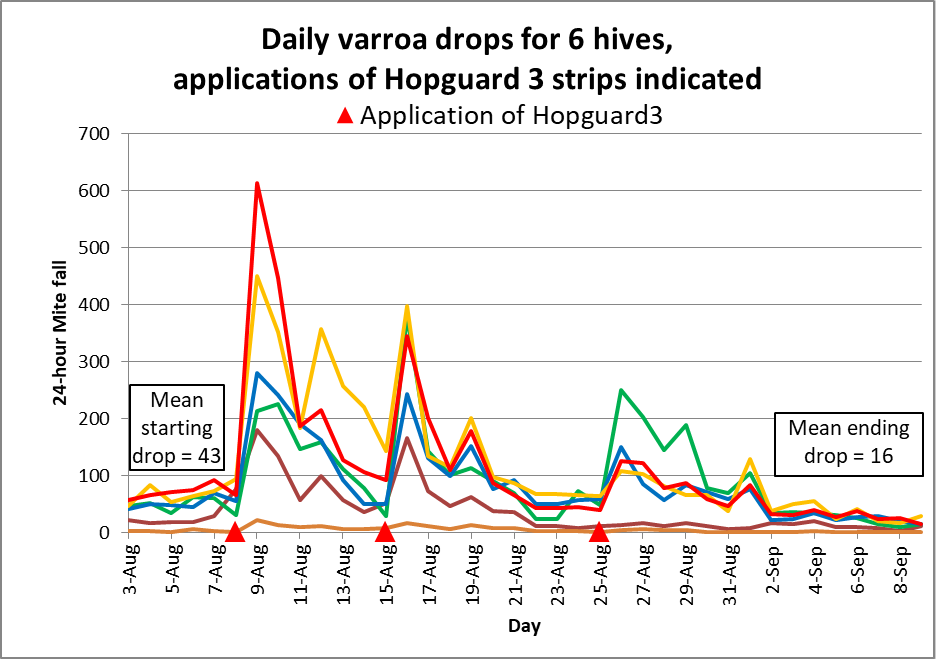
Fig. 1 There was an apparent wide range of varroa infestation rates of the monitored colonies, based upon their baseline and immediate post-treatment mite fall counts. Note how for even the highest-mite colonies, three treatments of Hopguard 3 brought daily mite drops down to low levels.
For better comparison, I summed up all the mite drop counts for the six hives each day, and compared them to the baseline count from the day before first application of Hopguard 3 (Figure 2).
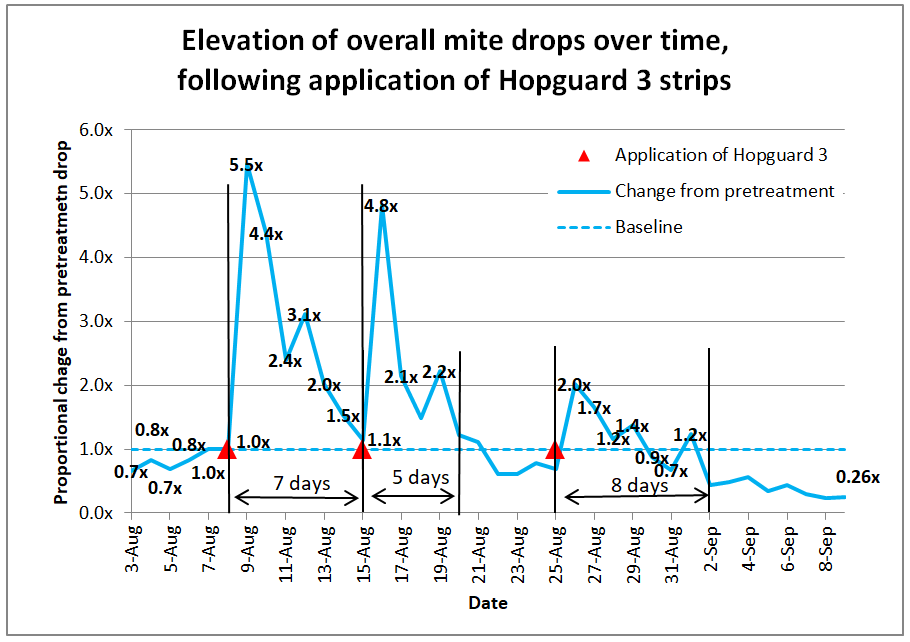
Fig. 2 By a month from the start, three repeated treatments with Hopguard 3 had steadily decreased daily mite drop down to a quarter of the baseline counts. In answer to the question of the residual activity of the strips, the effect appears to drop off by around 7 days. Data from Aris Roberts.
Practical application: Hopguard 3 may have extended the strips’ residual activity, but Aris’ data above suggests that it isn’t doing much after a week. So retreatment should be done within two weeks, in order to minimize the number of mites emerging from, and then reentering brood cells during the interim. Unfortunately, the above data were collected before I wrote the protocol for my own field test in California.
SUGGESTIONS FOR BEEKEEPERS WANTING TO DO RESEARCH
Aris shows us how even a teenage hobby beekeeper can collect very useful data of use to the beekeeping community. For more information on how you or a group can perform meaningful research yourselves, I’ve recently posted the slides for a presentation that I put together on how to perform bee research at [[8]]. I’m generally happy to help beekeepers with experimental design and protocols, and am willing to post good research by others at ScientificBeekeeping.com.
A FIELD TRIAL IN CALIFORNIA
Not yet knowing the optimal retreatment schedule for Hopguard 3, I consulted with Fabiana Ahumada, now at BetaTec Hop Products, who has been continually involved with the development of Hopguard since its early testing at the USDA Tucson Lab. We decided that I should test three applications at either 7- or 14-day intervals.
MATERIALS AND METHODS
I started the trial toward the end of the honey flow in late June, while there was still some incoming nectar and pollen. The weather was very hot and dry (Figure 3). Unfortunately, we had by that time controlled varroa in most of our yards, and the only colonies with mite levels high enough for collecting efficacy data were a group of untreated hives in my home yard, consisting mostly of “potential breeder queens” that had gone without mite treatment for over a year, but now had mite counts going up. I presciently wrote in my notes at the time that “the rate of mite increase in these colonies may be depressed relative to colonies that had not previously exhibited some degree of resistance to mite buildup.” As we’ll see, this concern turned out to be valid.
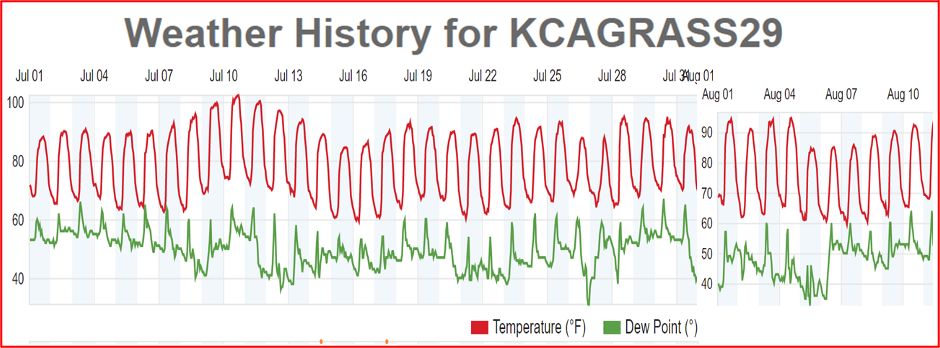
Fig. 3 The trial was run during hot weather in July and August, with daily highs typically in the 90s F.
All colonies were in double deeps, headed by 2nd-year queens. Colony strength ranged from 15-20 frames covered with bees (they had earlier been reduced in size to prevent swarming), all with brood in both boxes, and plenty of honey in the upper box.
We performed pretreatment mite washes on 27-28 June, taking level ½- cup samples of bees from frames adjacent to brood in the upper brood chamber, mechanically agitated them, and recorded the number of mites. I unfortunately could come up with only 18 hives with high enough mite counts to use for the trial. I assigned treatments in a randomized block design, blocked by starting mite count, with 7 hives in the weekly application group, 7 in the 14-day application group, and 4 hives with midrange counts [[9]] in the Control group. We took follow-up mite wash counts after one and two full bee brood cycles after first application of the strips, and again after 66 days, in order to determine the long-term effect of treatment. The experimental design is shown in Table 1.

We applied the first treatment to all hives the day after taking the first mite counts (Figure 4).
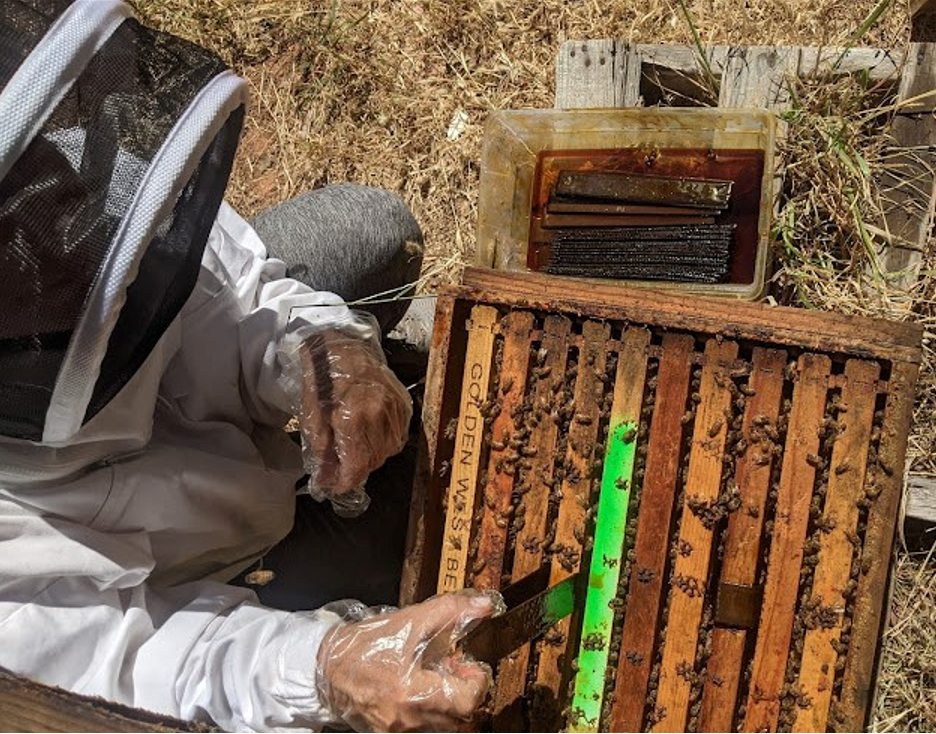
Fig. 4 Application of Hopguard 3 strips. We applied them (generously) as per label instructions of 1 strip per every 5 frames of bees. Most colonies got four strips, but the few with only 15-frame starting strength got only three. We removed the previous strips at each retreatment.
No mite treatment is completely harmless to the bees. The manufacturer cautions to smoke the top bars to cause the queen to move out of the way of a sticky strip as you insert it. If a bee gets rolled by a strip during the insertion process, we’ll find it dead on the landing board the next morning (Figure 5).
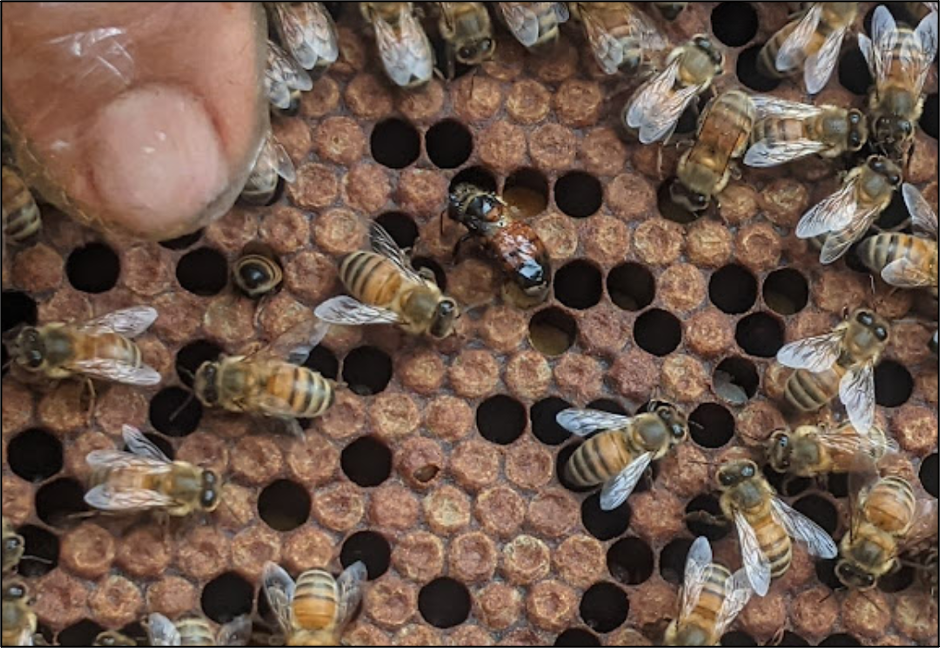
Fig. 5 The unfortunate wetted bee in the center of the photo will likely die from being rolled by an inserted strip. However, we’ve applied Hopguard to many hives, and have yet to see a queen get killed.
Application of Hopguard strips initially causes the bees to move broodrearing away from the strips (Figures 6 & 7).
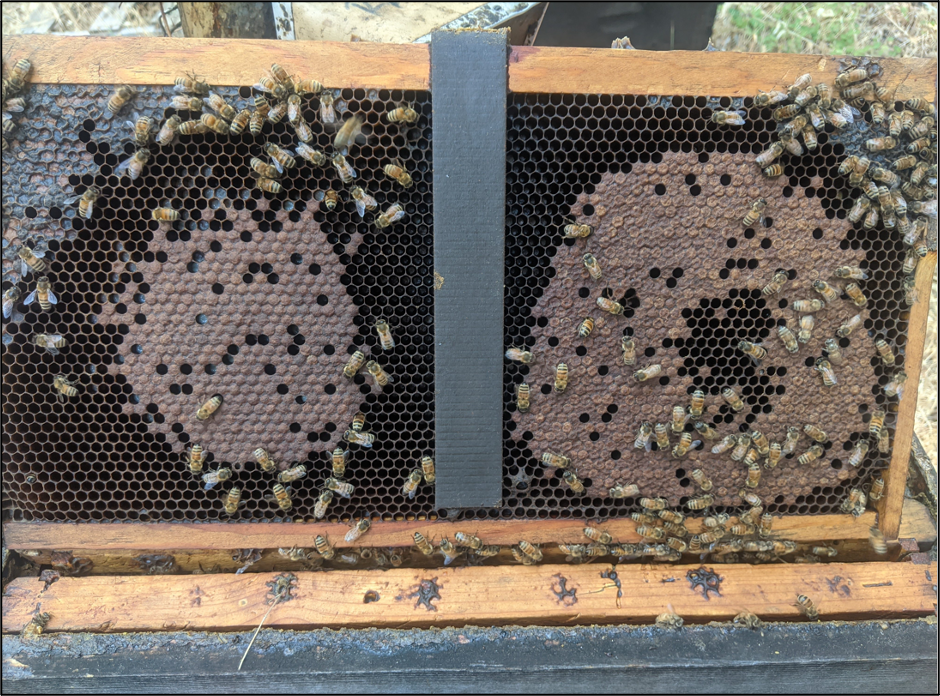
Fig. 6 Colonies tend to shift their brood rearing away from fresh strips.

Fig. 7 But after a couple of weeks, once the strips’ odor had dissipated, the bees will resume broodrearing under them, and eventually start chewing away at the strips to remove them.
I didn’t perform actual measurements, but my visual inspections indicated that there was more brood, especially open brood, in the Controls than in the treated colonies during treatment. This apparent suppression of broodrearing may help the treatment to work against varroa (similar to formic acid, thymol, and amitraz treatments, which also suppress brood rearing to some degree).
The honey flow began tapering off after starting the trial, so colony populations had already peaked. It was hard to tell, but there appeared to be an effect upon the cluster size from treatment. At the three-week assessments, the Control colonies covered all 20 frames in their hives, whereas the clusters in many of the treated colonies had shrunken somewhat. When I reapplied the Hopguard strips to the treated colonies, I often had to move the replacement strips inward to keep them within shrinking clusters (Figure 8).
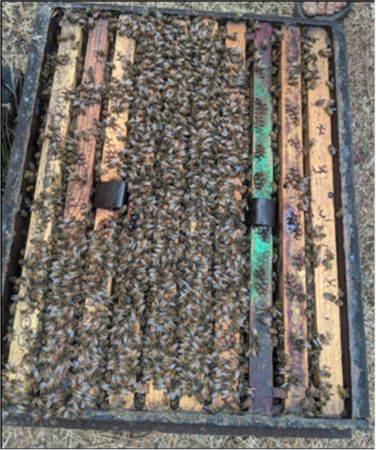
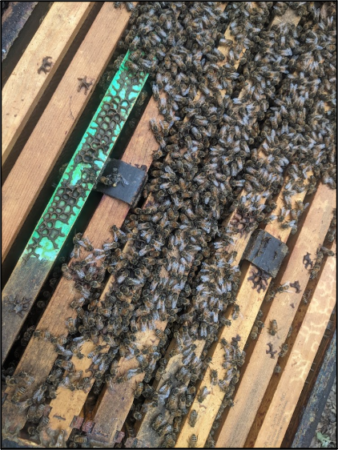
Fig. 8 The clusters tended to shrink a bit in the treated colonies. On the left is a typical colony immediately after application of the first treatment. In subsequent treatments (right), the clusters often no longer covered the strips. Despite this short-term effect, the colonies recovered quickly.
MY MISTAKE IN USING MITE-RESISTANT COLONIES
Let’s take a look at the mite wash counts for all the hives over the course of the trial (Figure 9).
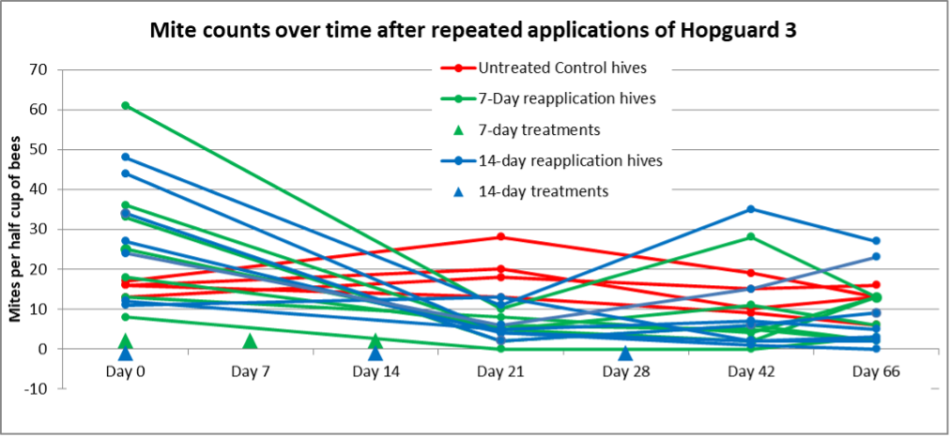
Fig. 9 Either application regimen reduced the infestation rate of the adult bees in both the short term or the long term. Three treatments with Hopguard 3 definitely knocked the mites back, but neither treatment zeroed out mite wash counts. But why the heck did mite counts also go down in the untreated Controls after that time?
Practical application: By two weeks after treatment, any mites that were originally hidden in the brood would have emerged, after which they generally spend a few days feeding on nurse bees before they reenter a brood cell in order to reproduce. The question then is, would retreatment at 7 days result in higher efficacy than at 14 days? To my surprise, it didn’t appear to make much difference.
It appears that it was a mistake for me to have used rejected potential breeder colonies (those that had mite counts increasing in their second season) for most of the hives in the trial, since all four Control hives eventually started to bring their counts down on their own (some exhibited strong uncapping and VSH behaviors; Figure 10). So this screwed up the expected increase of mite counts in the Control group, which prevented me from performing any meaningful efficacy calcs. Live and learn! This trial needs to be repeated using nothing but demonstrated non-resistant colonies.
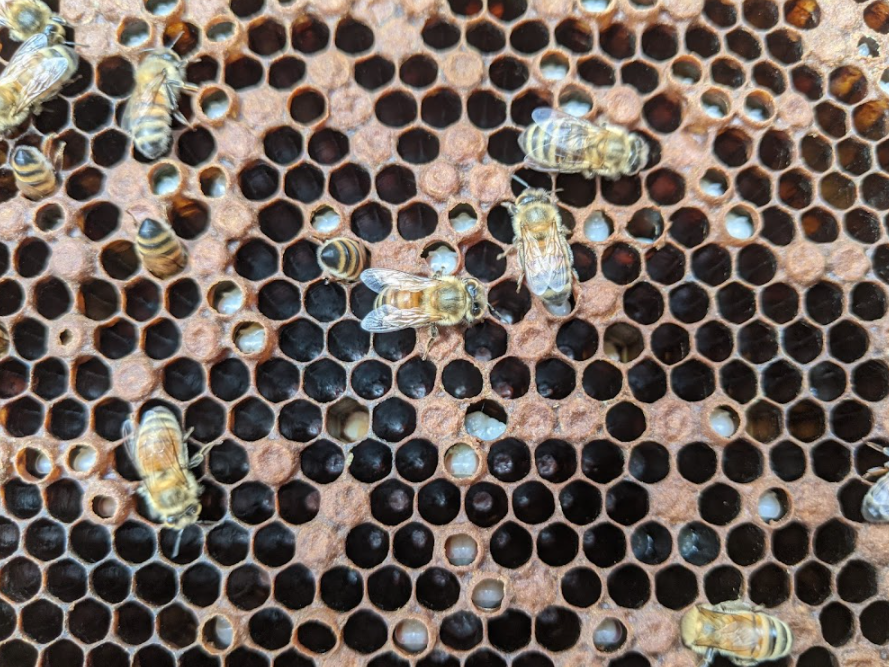
Fig. 10 Once their infestation rates got above a certain level, some of the Control colonies exhibited strong uncapping and/or “varroa sensitive hygiene” (VSH) behavior, which apparently was effective at reducing their infestation rates. I’ve seen other resistant colonies do the same — putting it into gear if varroa reaches a certain level.
Practical application: After five years of strong selection for mite resistance, roughly 10% of our colonies require no mite treatment whatsoever. When testing any miticide, I normally use high-mite colonies that obviously show no mite resistance. Unfortunately by the time I started this Hopguard trial, I’d already used up any high-mite colonies for other experiments, and thought that I could use some rejected potential breeders. In retrospect, that was not a good idea!
So perhaps the best interpretation of the data is to look at the percent changes in the average infestation rates for each treatment group over time (Figure 11).
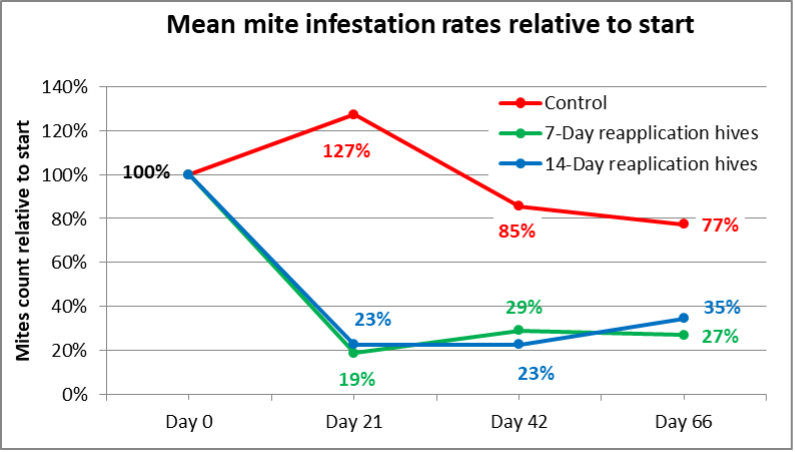
Fig. 11 So, what with the screwy Control group, can we salvage any meaningful information from this field trial? In this graph, I show the percentage of each group’s starting infestation rate (normalized to 100%) at each subsequent time point. At Day 21, by which point the count in the Control group had gone up by 27%, the Hopguard 3-treated groups had gone down by around 80% — not bad at all! [[10]]. Most tellingly, by the end of the trial at Day 66, the Hopguard-treated colonies still had mite infestation rates of around a third of what they started with. (Keep in mind that the trial wrapped up in early September, when mite counts generally rise substantially.)
THE TAKE-HOME
Although I was not able to calculate a legitimate figure for efficacy, I was impressed by Hopguard 3 for being a relatively-gentle mite treatment that could be used during hot weather without concern for queen loss or honey contamination.
Practical application: Similar to formic acid or oxalic dribble, Hopguard is fast-acting and highly efficacious on the “phoretic” mites on the adult bees, which is an important consideration when you want to reduce a high mite infestation rate quickly.
Based upon Aris’ findings that the strips are no longer much active after a week, the Day 66 infestation rates were taken a month to month-and-a-half after the treatments wore off, so the remaining mite populations would have had time to rebuild. These findings suggest that if you need to knock back varroa while you’ve got honey on the hive, two applications of Hopguard 3 two weeks apart provide pretty good control.
A single application of Hopguard 3 may be adequate if a colony is broodless (I’ve successfully used it myself at that time with good success), but it clearly takes at least two applications during the summer if a colony has an active broodnest. The overall efficacy from applying the strips every two weeks, rather than weekly, appeared to be about the same. This comes as a surprise to me, since I would have bet that the three weekly applications would have done a better job. So it looks like three applications might not be worth the cost or effort (it does take a bit of time to apply and remove the strips).
Practical application: Due to my mistake of using colonies with a degree of mite resistance, please do not consider this to be any sort of definitive trial of Hopguard 3. But based on this too-small and confounded test, I’d consider repeated treatment with Hopguard 3 to be a viable non-contaminating, food-grade, and “natural” “knockback” treatment for double-deeps while harvestable honey is on the hive. Since it appears to be relatively gentle on the colony, Hopguard 3 appears to be another valuable tool in our arsenal against varroa.
ACKNOWLEDGEMENTS
Thanks to Brion and Alice Dunbar for their assistance in my field trial.
CITATIONS AND NOTES
[1] https://scientificbeekeeping.com/mite-control-while-honey-is-on-the-hive-part-3/
[2] Rademacher, E., et al (2015). The development of HopGuard® as a winter treatment against Varroa destructor in colonies of Apis mellifera. Apidologie 46(6): 748-759.
[3] DeGrandi-Hoffman, G, et al (2012) The effects of beta acids from hops (Humulus lupulus) on mortality of Varroa destructor (Acari: Varroidae). Experimental and Applied Acarology 58(4): 407-421.
[4] Vandervalk, L, et al. (2014) New miticides for integrated pest management of Varroa destructor (Acari: Varroidae) in honey bee colonies on the Canadian prairies. Journal of economic entomology 107(6): 2030-2036.
[5] Nasr, M, et al (2014) An effective improved application method of HopGuard for varroa control in Canada. Available online.
[6] https://scientificbeekeeping.com/randys-varroa-model/
[7] Gregorc, A, et al. (2018). Toxicity of selected acaricides to honey bees (Apis mellifera) and varroa (Varroa destructor Anderson and Trueman) and their use in controlling varroa within honey bee colonies. Insects, 9(2), 55.
[8] https://scientificbeekeeping.com/tips-for-citizen-scientists/
[9] When testing for efficacy of varroa treatments, using mite washes as the metric, I’ve found that the percent mite reduction is usually substantially greater for higher-mite hives (https://scientificbeekeeping.com/mite-control-while-honey-is-on-the-hive-part-2/). This presents a problem if Control colonies are chosen randomly, since Controls that start with very high mite counts will often collapse prior to the end of the trial, but if you start with only low-mite Controls, they really can’t be considered to be legitimate controls. So for this trial, I used the four hives with mite counts in the middle as Controls.
[10] If I were trying to sell the product, I would have tossed any subsequent data, since I could have claimed 85% efficacy at that time point.



